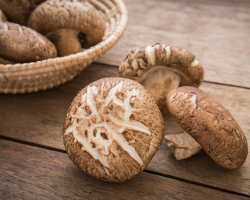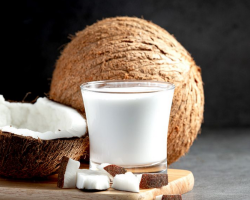Fitinic acid is a complex substance that can toxic to influence the body. Read more in the article.
Content
- What is phitinic acid?
- How does phytic acid affect the human body - benefits and harm: how to remove, neutralization by soaking cereals
- Video: This is how the ancestors cleaned fitin acid for health and longevity!
- Fitinic acid content: where, in which foods, table
- Fitinic acid: properties
- Fitinic acid and iron: what is the harm?
- Fitinic acid and zinc: What is the harm?
- Fitinic acid and calcium: What is the harm?
- Fitinic acid: cancer protection
- Video: Fitinic acid (phytates) in beans: anti -nitctative or anti -cancer? Dr. Michael Greger
- Fitinic acid: diabetes prevention
- Fitinic acid and cardiovascular disease
- Fitinic acid in cosmetology, for the face: peeling
- Fitinic acid: reviews
- Video: Fitinic acid (phytata). Harm or benefit? Dr. Michael Greger
- Video: Why is it so important to soak cereals, grains, nuts, legumes?
Fitinic acid It is a spare material of phosphorus compounds in the tissues of many plants. This is one of the natural substances (NSN) contained in plant products. It is known that it prevents the absorption of nutrients. However, this is not quite true.
Read on our website another article about folic acid: What is women for, what is its benefit? Will you learn how to take folic acid during pregnancy, during lactation, older women?
How does phytic acid affect the human body? What is the benefit from her? Look for answers to these and other questions in this article. Read further.
What is phitinic acid?

All cultures can be conditionally divided into 2 subgroups:
- One plants It is necessary that they are used by a living organism and process it, it is important for them for propagation. These crops are bright in color, easily digestible and very tasty. Such plants do not contain toxins that inhibit assimilation. These are berries, fruits of fruits and vegetables.
- Other plants Do not want them to eat. They are protected, hide the seeds in the shell, protecting spikelets with prickly processes. And the seed itself accumulates special toxins that make it almost inedible for animals, as they violate the digestive process. Such v-va called antinutrients.
Fitinic acid is an antinutrient. Such a substance not only blocks the phosphorus connected in it, but also takes from us the most important micro-elements-calcium, magnesium, iron and zinc.
How does phytic acid affect the human body - benefits and harm: how to remove, neutralization by soaking cereals

More than half of the population around the world suffers from a shortage of minerals, and the lack of iron and zinc is the most common. It is estimated that food, rich FC, such as grains or dry legumes, make up approximately 40–60% From the total number of calories consumed by man. How does phytic acid affect the human body? What is the benefit and harm?
That's what FC is harmful:
- He stops the production of fermented substances necessary for digestion of food, such as pepsin and threepsin (split proteins), as well as amylase (breaks down the starch particles to a glucose state).
- You can please yourself with a handful of nuts or rice porridge.
- But for men and women whose diet consists of whole grains and legumes, FC causes a very stringent lack of minerals.
It is worth noting:
- There is no enzyme in the gastrointestinal tract fitase, splitting FC.
- Therefore, in order to enrich the diet by easily assimilated minerals, the products must be correctly prepared for dinner or dinner.
- There are several ways to lower the content of FC. it soak, for example, cereals, nuts and seeds, cooking, germination and fermentation.
Experts have long discovered that soaking cereal grains and seeds during 8-24 hours at t 25 ° C, reduces the level of phytic acid by 17–25%. In addition, soaking along with cooking significantly enhances this effect.
Soaking is when the grains are completely immersed in water for a certain period of time, which activates phitase, which is also present in plant tissues. An increase in the soaking time increases the splitting of phytic acid. This was confirmed by the study. For example, an increase in the time of soaking chickpeas from 2 to 12 hours reduced the content of FC half. Germination and fermentation of millet seedlings at 30 ° C during 72 hours. contributed to neutralization of the amount of fitin to-you 88.3%.
Despite such harmful properties of this substance, it can be useful:
- If you consume fitin acid in moderation, it is even useful, and our microflora can get used to its excessive quantity.
- Such a substance can be useful for problems with vessel calcinosis, kidney stones, and an excess of iron, although there are better methods.
Fitinic acid in small quantities acts as an antioxidant and has other nuclear features.
Video: This is how the ancestors cleaned fitin acid for health and longevity!
Fitinic acid content: where, in which foods, table
FC is in cereals - wheat, halfba, rye, oats, barley, rice, sorghum, oilseeds, beans, including soybeans. In the husk of different fruits and seeds, this substance is present in huge quantities. For this reason, whole grain cereals are richer than this substance than their refined analogues.
The content of phytic acid in some foods (g/100 g):
| № | Product name | Content in 100 g |
| 1. | Corn | 6,39 |
| 2. | Wheat | 2,10–7,30 |
| 3. | Wheat bran | 1,14–3,39 |
| 4. | Rice bran | 2,56–8,70 |
| 5. | Barley | 0,38–1,16 |
| 6. | Oats | 0.42–1,16 |
| 7. | Millet | 0,18–1,67 |
| 8. | White beans | 0,61—2,38 |
| 9. | Peas | 0,22–1,22 |
| 10. | Chickpeas | 0,28–1,60 |
| 11. | Lentils | 0,27–1,51 |
| 12. | Soy | 1.00-2.22 |
| 13. | Sesame | 1,44–5,36 |
| 14. | Almond | 0,35—9,42 |
| 15. | Walnuts | 0,20–6,69 |
| 16. | Seeds | 3.5-3.7 |
| 17. | Buckwheat | 1.42-1.5 |
| 18. | Linen | 0.3-0.44 |
When processing plant materials, the content of phytic acid is reduced. Losses range from 20% When processing grain up to 50% When baking bread. The substance decomposes during storage, fermentation, soaking, germination and cooking.
Fitinic acid: properties
As mentioned above, fitinic acid has both a negative and positive effect on the human body.
- Reduces the absorption of minerals, including iron, zinc and calcium. It connects with them with the formation of insoluble salts. Thus, this prevents their absorption from the gastrointestinal tract and the use of the body.
- Fitinic acid is also associated with proteins, which reduces their solubility.
- It helps to suppress the activity of the enzymes that are necessary in the digestive processes, that is, pepsin, trypsin, lipase, amylase.
However, phytic acid is a powerful antioxidant that neutralizes free radicals. They are formed as a result of metabolic processes of the cell and under the influence of external factors (environmental pollution, UV radiation, ionizing radiation). Free radicals cause damage to the cells of the body, which leads to a change in genetic material. The body has many ways to remove such active forms. For example, he produces his own strong antioxidant - glutathione, reinforced with phytinic acid.
Fitinic acid and iron: what is the harm?

Iron performs a number of important functions in the body, including:
- Participates in tissue breathing
- It is necessary for the production of red blood cells
- Supports the immune system
- Helps in detoxification of the body
- Participates in the creation of genetic material (DNA)
What is the harm? Up to 2 billion people around the world suffer from iron deficiency and this leads to the development of anemia. Such a pathology is manifested:
- A decrease in physical performance
- Worsening concentration
- Hair loss
- The formation of ulcers in the corners of the lips
- The pallor of the skin
- Reducing immunity
It is worth knowing: Anemia can lead to an increase in the concentration of some heavy metals in the body (cadmium, lead), which entails the development of depression.
A high content of phytic acid increases the risk of anemia. This substance forms insoluble salts with iron. Studies of scientists show that, for example, a sweet roll of wheat flour containing 2 mg, 25 mg and 250 mg Fitinic acid will inhibit iron absorption in the body 8%, 64% and 82% respectively.
Fitinic acid and zinc: What is the harm?
Estimated, 49% The world's population consumes too little zinc. This substance is a very important trace element for the human body. It includes more than 300 enzymes. Participates in the transformation of proteins, carbohydrates and fats. It is necessary for the production and functioning of hormones and supports the immune mechanisms of the body. What is the harm?
Zinc deficiency leads to:
- Impairment of immunity
- Growth retardation, puberty
- Violations of smell and taste
- Cognitive disorders
Zinc is contained in products of plant and animal origin. However, it is from animal products that it is better absorbed. All due to the presence in the plant raw materials of anti-hideous compounds, including phytic acid.
Fitinic acid limits the bioavailability of zinc, which was confirmed by research. Participants were given a soy drink containing a soy drink 50 mg zinc and various amounts of phytic acid - 0.13 g and 0.26 g. A few minutes after consumption 200 ml of drink, controlled the content of zinc in the body. It turned out that phytic acid significantly reduces zinc absorption.
Fitinic acid and calcium: What is the harm?
Calcium is an important mineral that not only strengthens bones and teeth. In addition, it is involved in the nervous conduction and contractility of muscles, regulates the hormonal balance and participates in blood coagulation. Chronic calcium deficiency leads to the development of rickets in children and osteomination or osteoporosis in adults.
Calcium is the main mineral that is involved in the processes of the structure of tissues of bones and teeth. Milk and dairy products are a rich source of calcium. Currently, many people are allergic to the protein of cow's milk or do not tolerate lactose. Therefore, they must satisfy the need for calcium from plant products, for example, dry legumes. The digestibility of calcium in products of this type is limited due to the content of phytic acid.
Fitinic acid: cancer protection

Helating properties of phytic acid contribute to the removal of metals ions, including iron. Excess iron is toxic to the body. It contributes to the formation of free radicals, including especially reactive hydroxyl (it) radical, which is carcinogenic.
Fitinic acid helps to stop the cell cycle, inhibit the differentiation of membranes and even the destruction of neoplastic cells. In addition, such a substance is associated with starch, which is not split during digestion, and in a constant form enters the large intestine. Here he is involved in the formation and excretion of feces. Due to this, harmful compounds are removed on an ongoing basis. Moreover, in the process of fermentation of starch intestinal microbiota, short -chain fatty acids are formed, which change p The gastrointestinal environment and protect against cancer.
Fitinic acid can show a positive effect in the case of cancer of the colon and colon, the mammary gland and prostate.
Video: Fitinic acid (phytates) in beans: anti -nitctative or anti -cancer? Dr. Michael Greger
Fitinic acid: diabetes prevention
Fitinic acid can act prophylactically with diabetes. Studies on rats showed that this substance reduces the level of glucose in the blood. This is due to a decrease in the activity of amylase (enzyme that digress carbohydrates), as well as with a slower emptying of the stomach and a partial process of digestion of starch. Fitinic acid also affects the secretion of insulin with pancreatic beta-cells. Therefore, it can act as a prophylactic for diabetes.
Fitinic acid and cardiovascular disease

Fitinic acid can give a positive effect in diseases of the cardiovascular system. The tests on rats showed that the substance helps to reduce the concentration of triglycerides in the blood and at the same time increase the amount of good cholesterol - LPR -LDP lipoproteins. In addition, it prevents calcification of the cardiovascular system and acts as an anticoagulant.
As you can see, fitinic acid can be useful. There is harm in abundance, since the bioavailability of some minerals, such as calcium, iron and zinc, is reduced. However, in moderate quantities, this substance gives a positive effect. As an antioxidant, it can perfectly act against cancer, improve a lipid profile and reduce blood glucose.
Fitinic acid in cosmetology, for the face: peeling
Fitin peeling - a cosmetic procedure aimed at deep cleansing of the skin by means of phytic acid. The substance is obtained from wheat or rice cake, which remains after squeezing oil. Such peeling is considered delicate, recommended for dry, supersensitive, problematic and wilting skin.
Advantages of phytic acid in cosmetology, for the face in the form of peeling:
- Quick effect without discomfort and soreness
- Good antioxidant activity
- Suitable for all skin types, even sensitive, prone to rosacea
- The ability to spend at any time of the year
- Accessibility and simplicity of the procedure
- The minimum risk of complications
Fitinic acid peels are very popular. For the treatment of different skin problems, other ingredients can be added, in addition to the main substance, in addition to the main substance. For treatment:
- Melasms add retinoic and glycole acids
- Curoperosis - glycolic or wine acid
- Age spots - azelain acid and resorcin
- Peeling of the skin only the main ingredient is used
It is worth noting that pH Such creams are 1,0-1,5. They can be used at home, clearly adhering to the recommendations of the manufacturer.
Fitinic acid: reviews

Video: Fitinic acid (phytata). Harm or benefit? Dr. Michael Greger
Video: Why is it so important to soak cereals, grains, nuts, legumes?
Read on the topic:
- Folic acid for women after 50 years: benefit and harm
- Amber acid in home cosmetology from face wrinkles, under the eyes
- TOP-10 Best Facial Pilling Skatkok: with chamomile, apple, snail mucin
- Acid face peeling: Indications, how to make it right, photos before and after, reviews
- All about acids in face cosmetics - how they work: application, description, reviews







